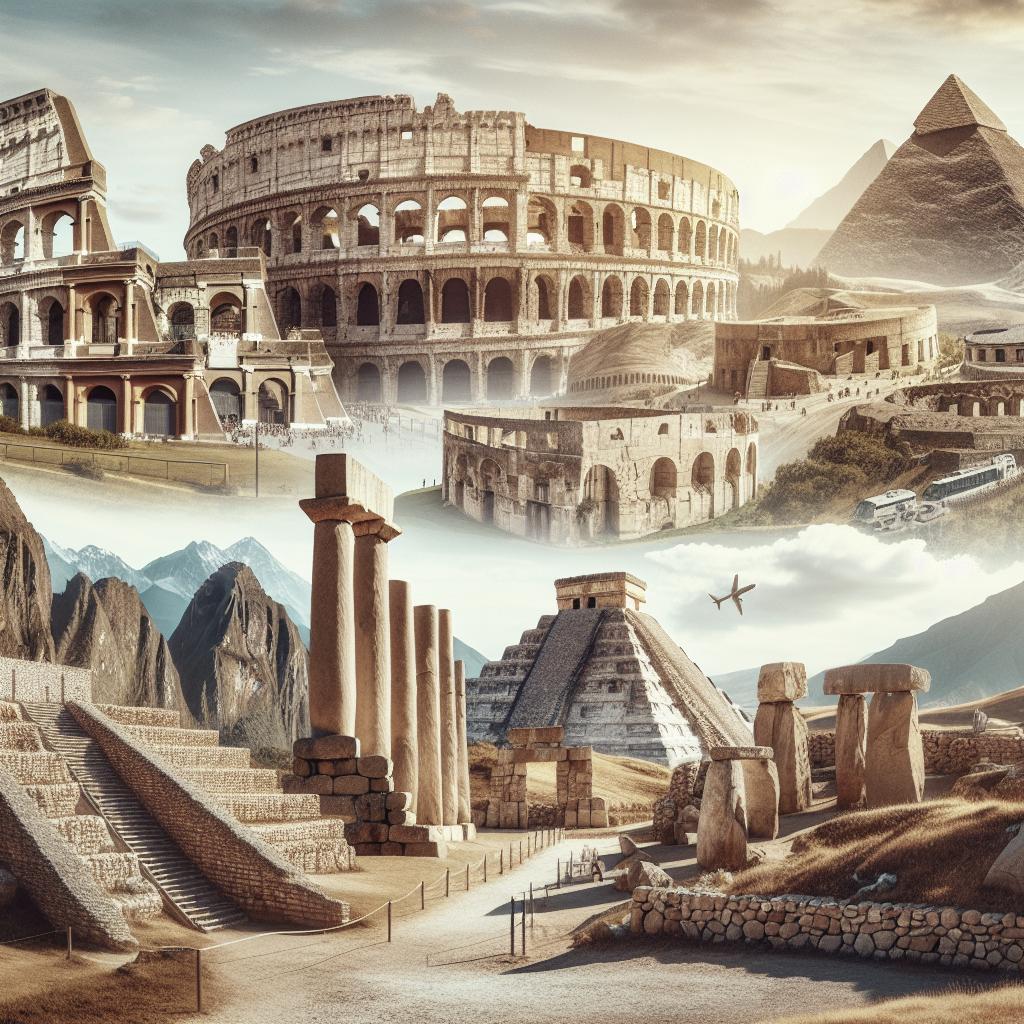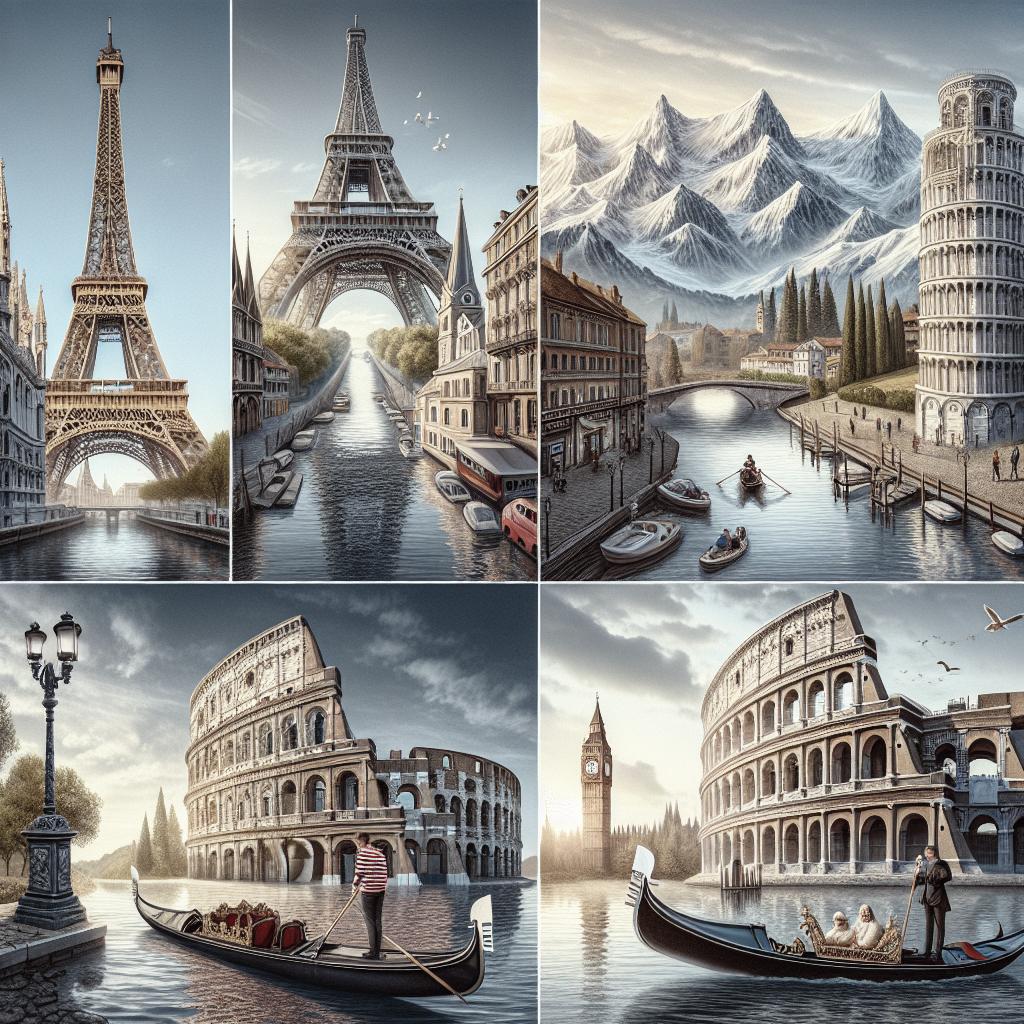“`html
Top Historical Sites to Visit Worldwide
The world is filled with historical wonders that whisper tales of civilizations long gone. In this blog post, we’ll explore some of the most awe-inspiring historical sites to visit across the globe. From the majestic ruins of Machu Picchu to the intricate carvings of Sukhothai, these sites offer a glimpse into the past, telling stories of ancient cultures and empires. Whether you’re an avid history buff or a curious traveler, these destinations promise to leave you with unforgettable memories and a deeper understanding of human history. Join us as we journey through 16 of the world’s most renowned historical marvels.
1. Machu Picchu
Nestled high in the Peruvian Andes, Machu Picchu is one of the most iconic archaeological sites in the world. Built in the 15th century by the Inca Empire, this stunning citadel was rediscovered in the early 20th century and has since captivated the imaginations of millions. Surrounded by lush greenery and steep terraces, Machu Picchu offers breathtaking views and an in-depth look into the advanced architectural techniques of the Incas.
The site consists of more than 150 buildings ranging from temples and sanctuaries to baths and houses. Its construction is a feat of engineering, with precisely cut stones fitting together without the use of mortar. Exploring Machu Picchu is an unforgettable experience, with its rich history and magnificent views making it a must-see for any traveler.
2. Tikal
Located in the heart of the Guatemalan rainforest, Tikal was one of the major cultural and population centers of the ancient Maya civilization. This sprawling site features towering limestone temples that rise above the jungle canopy, offering panoramic views of the surrounding rainforest. As one of the largest archaeological sites in the Americas, Tikal provides a fascinating insight into Maya architecture, symbolism, and mythology.
Tikal’s vibrant past can be seen in its intricate hieroglyphic inscriptions and finely carved stelae commemorating historical events and rulers. The main plaza, with its impressive Temple I and II, serves as the core of this ancient metropolis, representing the architectural prowess and urban planning skills of the Maya.
3. The Pyramids at Giza
The Pyramids at Giza are Egypt’s most famous monuments and among the most recognizable historical sites in the world. These ancient wonders have stood the test of time, with the Great Pyramid of Giza being the largest and oldest of the group, believed to have been constructed as a tomb for Pharaoh Khufu around 2,500 BC. The precise alignment and construction of the pyramids continue to be a marvel for engineers and historians alike.
Nearby, the Sphinx, a massive limestone statue with the body of a lion and the head of a pharaoh, adds to the mystery and allure of this great site. Giza’s pyramids remain symbols of ancient Egypt’s power and architectural genius.
4. Angkor Wat
Angkor Wat, situated in Cambodia, is the largest religious monument in the world and a UNESCO World Heritage Site. Originally constructed in the early 12th century as a Hindu temple dedicated to Vishnu, it was later transformed into a Buddhist temple. The grandeur of Angkor Wat is unmatched, with its iconic five towers symbolizing Mount Meru, the center of the universe in Hindu and Buddhist cosmology.
The temple’s walls are adorned with intricate bas-reliefs depicting Hindu mythology and Khmer history. Sunrise at Angkor Wat is a magical experience, with the sun casting a golden hue on the temple’s labyrinth of corridors, terraces, and chambers.
5. Petra
Hidden amidst the rugged mountains of southern Jordan, Petra is an archaeological city that continues to mesmerize visitors with its impressive rock-cut architecture and rich history. Also known as the Rose City due to the reddish color of the sandstone cliffs, Petra was the capital of the Nabataean Kingdom and a major trade hub in ancient times.
The most famous structure in Petra is the Treasury, whose intricate façade has been sculpted from the vibrant sandstone. Explorers can wander through the narrow gorge, known as the Siq, to discover the treasures of the ancient city that range from temples and tombs to water channels and rock engravings.
6. Stonehenge
Stonehenge is one of the most renowned prehistoric monuments in the world, located on Salisbury Plain in England. This mysterious stone circle dates back to around 2500 BC and continues to intrigue researchers and visitors with its purpose and construction methods. Comprising an outer ring of massive sarsen stones and a smaller inner ring, Stonehenge is considered a marvel of ancient engineering and astronomy.
The site is associated with numerous myths and legends, with some theories suggesting it was used as an astronomical observatory or a religious site. Regardless of its original function, the mystery of Stonehenge remains one of its most captivating features.
7. The Colosseum and Forum
The Colosseum and Roman Forum in Rome are iconic symbols of ancient Roman civilization. The Colosseum, completed in AD 80, was the largest amphitheater of its time and the stage for gladiator contests and public spectacles. Its massive structure, consisting of stone and concrete arches, has endured centuries of wear and stands as a testament to Roman architectural prowess.
Just a short walk away, the Roman Forum was the center of political, religious, and social life in ancient Rome. As you wander through the ruins of temples, basilicas, and public spaces, you can envision the bustling heart of a once-mighty empire.
8. The Parthenon
Standing atop the Acropolis in Athens, Greece, the Parthenon is a symbol of classical Greek architecture and democracy. Built in the 5th century BC, this Doric temple stands as a tribute to Athena, the goddess of wisdom and warfare. The Parthenon exemplifies ancient Greek architectural precision through its use of columns and the intricate detailing of the frieze and pediments.
While time and conflict have taken their toll on the Parthenon, recent restoration efforts aim to preserve its historical significance and architectural beauty. Visiting the Parthenon offers a glimpse into ancient Greek culture and the ideals that shaped Western civilization.
9. Easter Island
Easter Island, known as Rapa Nui by its indigenous people, is home to the enigmatic moai statues that have intrigued historians and travelers alike. Over 900 of these monolithic statues are scattered across the island, each bearing unique features and expressions. The story of the island’s settlers and their mysterious disappearance adds to the allure of Easter Island.
The island is remote, situated in the Pacific Ocean far from mainland Chile, giving it an air of mystery and wonder that is unmatched elsewhere. Exploring Easter Island offers insights into the beliefs, culture, and dynamics of the Polynesian society that once thrived there.
10. Taj Mahal
The Taj Mahal, located in Agra, India, is an architectural masterpiece and a symbol of love and devotion. This stunning white marble mausoleum was commissioned by Emperor Shah Jahan in memory of his beloved wife Mumtaz Mahal and completed in 1648. Its symmetrical layout, exquisite gardens, and detailed carvings make it one of the most beautiful buildings in the world.
The central dome, surrounded by four minarets, gives the Taj Mahal its distinctive outline, while the intricate inlay work of precious gemstones adds to its beauty. Visiting the Taj Mahal, especially at sunrise or sunset, is an unforgettable experience, as the changing light enhances its architectural splendor.
11. The Alhambra
The Alhambra in Granada, Spain, is a stunning example of Moorish architecture and design. Originally built in the 13th century, this palatial complex served as a fortress and later became the residence of Nasrid sultans. With its intricate Islamic art, beautifully landscaped gardens, and strategic hilltop location, the Alhambra is a testament to the sophistication and cultural blend of Muslim rule in Spain.
Visitors can admire the ornate stucco work, stunning tile mosaics, and lush courtyards, each contributing to the site’s serene and majestic atmosphere. The Alhambra remains one of Spain’s most popular attractions and a significant historical monument.
12. The Great Wall of China
The Great Wall of China, a UNESCO World Heritage Site, stands as an engineering marvel and a symbol of resilience and determination. Spanning approximately 13,000 miles, it was built over several dynasties, with the majority of construction taking place during the Ming Dynasty (1368–1644). The wall served as a defensive barrier against invasions from northern tribes and foes.
With its watchtowers, battlements, and steep ascents, the Great Wall is a testament to the ingenuity and perseverance of the ancient Chinese civilization. Walking along the wall provides breathtaking views of the surrounding landscape and a profound sense of history.
13. Chichén Itzá
Chichén Itzá, located in Mexico’s Yucatán Peninsula, is one of the most famous archaeological sites of the ancient Maya civilization. As a UNESCO World Heritage Site, it showcases a fusion of Maya and Toltec cultures, which is evident in its architectural and art styles. The most recognizable structure at Chichén Itzá is the Temple of Kukulcán, also known as El Castillo, an impressive step pyramid that dominates the central plaza. Its design and orientation are closely linked to the Mayan calendar, reflecting the astronomical knowledge of the time.
A visit to Chichén Itzá also reveals various other structures, including the Great Ball Court, the Temple of the Warriors, and the Sacred Cenote, a natural sinkhole that played vital roles in Maya spirituality. The artful carvings and complex historical layers of the site offer visitors a glimpse into a remarkable civilization.
14. Volubilis
Volubilis is a partially excavated ancient city in Morocco, highlighting the remnants of Roman architecture in North Africa. Once a thriving center for olive production and trading, Volubilis became the furthest outpost of Rome’s presence in Morocco. Its strategic location made it an important city in the Roman Empire.
Visitors to Volubilis can explore various structures, including beautifully preserved mosaics, thermal baths, a basilica, and the impressive Arch of Caracalla. The site offers panoramic views of the fertile valley surrounding it, making Volubilis not only an archaeological treasure but also a place of natural beauty.
15. Sukhothai
Sukhothai, often referred to as the cradle of Thai civilization, was the capital of the first Kingdom of Siam in the 13th and 14th centuries. Today, the historical park at Sukhothai, a UNESCO World Heritage Site, offers a glimpse into the early days of Thai culture and architecture. The park preserves numerous well-preserved temples and crumbling ruins, surrounded by moats, canals, and lush greenery.
The iconic Wat Mahathat stands at the heart of the park, with its large seated Buddha statues and intricate stucco work reflecting Sukhothai’s architectural achievements and artistry. Exploring Sukhothai’s historic gems provides insight into the kingdom’s cultural, spiritual, and political history during its Golden Age.
16. Pompeii
Pompeii, located near modern-day Naples in Italy, offers a unique snapshot of ancient Roman life, frozen in time by the catastrophic eruption of Mount Vesuvius in AD 79. The volcanic ash that blanketed the city has remarkably preserved buildings, frescoes, and even the casts of victims, providing invaluable insight into Roman urban planning, art, and daily activities.
Visitors can roam through the excavated streets of Pompeii, discovering grand villas, ancient bathhouses, public arenas, and market squares as they once were. The haunting beauty and historical importance of Pompeii make it a compelling destination for anyone interested in the intricacies of Roman society and the devastation wrought by natural forces.
Summary of Main Points
| Site | Location | Notable Features |
|---|---|---|
| Machu Picchu | Peru | Inca Citadel, Terraces, Engineering Marvels |
| Tikal | Guatemala | Maya Temples, Hieroglyphics, Jungle Views |
| The Pyramids at Giza | Egypt | Great Pyramid, Sphinx, Ancient Engineering |
| Angkor Wat | Cambodia | Largest Religious Monument, Hindu/Buddhist Art |
| Petra | Jordan | Rose-Red Rock Architecture, Trade Hub |
| Stonehenge | England | Prehistoric Stone Circle, Astronomical Site |
| The Colosseum and Forum | Italy | Roman Architecture, Gladiator History |
| The Parthenon | Greece | Doric Temple, Cultural Symbol of Ancient Greece |
| Easter Island | Chile | Moai Statues, Polynesian Culture |
| Taj Mahal | India | White Marble Mausoleum, Architectural Marvel |
| The Alhambra | Spain | Moorish Architecture, Ornate Design |
| The Great Wall of China | China | Defensive Wall, Engineering Feat |
| Chichén Itzá | Mexico | Maya-Toltec Fusion, Astronomical Significance |
| Volubilis | Morocco | Roman Architecture, Stunning Mosaics |
| Sukhothai | Thailand | Ancient Thai Kingdom, Preserved Temples |
| Pompeii | Italy | Preserved Roman City, Volcanic Ash Preservation |
“`


